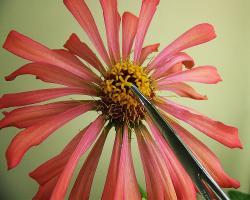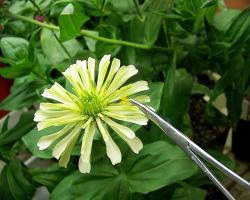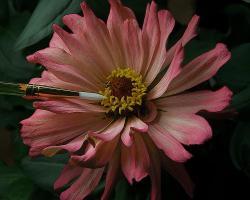Hi Kayleigh,
 " Are there F1 hybrid Zinnias that will not produce seeds? "
" Are there F1 hybrid Zinnias that will not produce seeds? "
All of the commercially available F1 hybrids can produce seeds. Some research interspecific hybrids are sterile.
" Do the interspecifics produce seeds? "
All the commercially available interspecifics (Profusions, Zaharas, and Pinwheels) do produce seeds. In fact, they are grown open pollinated in fields. They are of hybrid origin, but they are not hybrids.
" I notice Profusion series is called "interspecific"; what does that mean? "
The Profusions, Pinwheels, and Zahara zinnias are members of the man-made zinnia species,
Zinnia marylandica. That species was created from an interspecies cross between Zinnia elegans (called Zinnia violacea in academic circles) and Zinnia angustifolia. Z. elegans has 24 chromosomes and Z. angustifolia has 22 chromosomes, so the hybrid has 23 chromosomes. Plants with an odd number of chromosomes are sterile, so the plant scientists used Colchicine to double the 23-chromosome number of the hybrids to 46 chromosomes. The 46-chromosome zinnias were named Zinnia marylandica in honor of the University of Maryland, where much of that research was done. The 46-chromosome Z. marylandicas are true breeding and open pollinated.
" Even though they don't readily cross with others, do they readily cross with themselves? "
Yes, they grow just fine in an open pollinated environment.
" More specifically, I want to grow Dreamland variety. Seeds are even higher than Profusion and they are noted as being F1. "
Unfortunately some seed catalog copy writers do not understand the difference between hybrid origin and actual F1 hybrids and since F1 hybrid seed commands a higher price, it is not at all unusual for open pollinated varieties to be falsely labelled as F1 hybrids. In the case of Dreamland, the "fair" price is about 12 cents per seed. That price might indicate that they are F1 hybrids, but unfortunately they are listed as F1 hybrids in some catalogs and not in others. Incidentally, the Magellans are another competitive variety -- have you considered them? You mention "high dollar". What prices are you seeing?
" In Zinnias, crossing an F1 with an F1 (same variety), will it likely produce something very similar, do you think? "
Selfing or crossing F1s results in genetic recombinations, which may not be similar.
" Since they are dwarf, perhaps I could grow them in 2 or 3 gallon containers. Do you have any suggestions for isolating them, or do they have to be isolated by the individual flower? "
I wouldn't go to that much trouble. I would arrange the containers according to how they looked.
" In reading this thread, I don't see you mention those (isolating flowers), or any photos as to how you actually harvest pollen and pollinate, or did I miss it? "
Isolation is only for commercial seed producers. It has to do with separating different varieties of zinnias by very long distances, perhaps nearly a mile. Bees are long distance fliers, and isolating doesn't work for the home gardener. I don't even attempt it.
I don't remember where or if (in this thread) I went into the specifics of harvesting and using zinnia pollen. Zinnia pollen is very short-lived, and lives for less than a day. I usually use it within a few minutes of the time I "pick" the floret. The fuzzy yellow star-fish-shaped pollen florets emerge in the morning, their timing depending on weather and temperature. As they open, they spill pollen out on the fuzzy yellow arms of the floret. I pick the florets and rub them on the stigmas that I wish to fertilize. Sometimes I use an artists brush to dip in the pollen and transfer it. All that said, cross pollinating zinnias is very easy and it goes rapidly. You can pollinate several blooms in a few minutes, which could create seeds for a garden full of your home hybridized zinnias. I'll toss in some photos here. I do most of my cross-pollinating with tweezers or forceps. Indoors the pollen stays put to make artists brushes feasible.


This is the pollen transfer using an artists brush.


The target for the pollen is the Y-shaped stigmas at the base of each petal. Each stigma fertilizes a single seed attached to the base of the petal. If you have have any questions, please ask. I think we should be able to find some more reasonably priced Dreamland and/or Magellan seeds if you need more than a few seeds. Small packets do charge much higher prices per seed.
ZM




